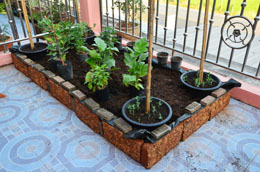Raised bed gardening involves growing plants on a raised soil platform. This article explains what this style of gardening is like and its benefits.

Hand picked fresh home grown vegetables have no substitute in flavor and nutrition. Though growing your own vegetables has its own advantages, though it can be tedious. Planting, pruning, weeding, watering, fertilizing, and a constant vigilance for those little pests who always want the first bite can be quite back breaking. A raised bed to grow your plants in is an excellent way to arrange your garden and enjoy a bountiful harvest.
Gardening with Raised Beds
It is a system where you can grow plants in a small concentrated area. The soil is raised and held from all sides in the shape of a square, rectangle, or circle. The bed is generally 3 to 4 feet wide and the length is as per the requirement. Planning this type of garden is very similar to planning a vegetable or flower garden. Here are a few easy steps:
Location
Choose a spot that receives plenty of sunlight and is not surrounded by too many trees. Ensure a good drainage facility to avoid water logging in the beds.
Materials
Holding the soil in place is essential for good growth of the plants. There are different types of materials to choose from such as plastic, vinyl, fiberglass, stone, cinder blocks, bamboo, bricks, or wood. It is best to avoid pressure-treated lumber, as the chemical from it tends to seep into the soil. Your frames should be sturdy enough to hold the soil together. Constantly draining the soil will weaken the delicate roots of your plants.
Soil Preparation
Good soil ensures good growth; this is what every good gardener believes in. The advantage here is the amendments you can make to the quality of the soil. The frame should be filled with light-weight, humus-rich soil mixed with organic composite. Humus-rich soil holds extra nutrients and earthworms, microorganisms, and acids present in the soil, release them slowly and over a long duration. It's preferable to keep your beds way from big trees, as their roots tend to compete for the nutrients and water. A well-built bed can last for years, and it's easy to maintain soil fertility. The soil should be 8 to 12 inches above ground level as it keeps the soil warm and provides better drainage.
Growing Plants
Choose the vegetable type and quantity you would like to grow. It's best to prepare a layout for your beds. Vines need more room and tend to entangle others in their vicinity, it's best to grow them separately. Taller plants should be grown in a place where they can't cast a shadow on the other smaller plants around them. Different varieties can be grown in the same bed and can be planted closer, to make the best use of the space. Water thoroughly after planting the saplings, and mulch around the plants after a day or two to maintain the moisture in the soil.
Advantages
- No soil compaction: In most gardens, it isn't possible to avoid stepping on the garden bed, leading to soil compaction, blocking the air from reaching the plant roots. A raised bed allows you to do all your activities from the sides of the bed, without stepping on the bed.
- Soil: You can control the soil quality and type as per your need from bed to bed. Since you are importing soil to raise the height of the bed, you can select the soil and amend its conditions by adding fertilizers or composite.
- Weeds and pest: They are easier to control in small spaces. Since your plants are spaced closer, it leaves very little room for the weeds to spread. Any damage done to the plants by the insects and pests is easily visible and can be controlled at the onset.
- Access: Plants can be reached easily and all gardening activities can be carried out comfortably from the garden path. No more bending and experiencing backache.
Raised beds do not need expensive equipment for cultivation and require minimum maintenance. They bring orderliness and add to your landscape. You can enjoy the benefits of a big vegetable garden in a small space.






 Hand picked fresh home grown vegetables have no substitute in flavor and nutrition. Though growing your own vegetables has its own advantages, though it can be tedious. Planting, pruning, weeding, watering, fertilizing, and a constant vigilance for those little pests who always want the first bite can be quite back breaking. A raised bed to grow your plants in is an excellent way to arrange your garden and enjoy a bountiful harvest.
Hand picked fresh home grown vegetables have no substitute in flavor and nutrition. Though growing your own vegetables has its own advantages, though it can be tedious. Planting, pruning, weeding, watering, fertilizing, and a constant vigilance for those little pests who always want the first bite can be quite back breaking. A raised bed to grow your plants in is an excellent way to arrange your garden and enjoy a bountiful harvest.